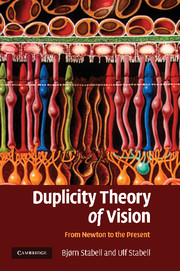Book contents
- Frontmatter
- Contents
- Acknowledgements
- 1 Introduction
- Part I The development of the basic ideas of the duplicity theory from Newton to G. E. Müller
- Part II The development of the duplicity theory from 1930–1966
- Part III Chromatic rod vision: a historical account
- Part IV Theories of sensitivity regulation of the rod and cone systems: a historical account
- Part V Factors that triggered the paradigm shifts in the development of the duplicity theory
- References
- Index
Part V - Factors that triggered the paradigm shifts in the development of the duplicity theory
Published online by Cambridge University Press: 22 January 2010
- Frontmatter
- Contents
- Acknowledgements
- 1 Introduction
- Part I The development of the basic ideas of the duplicity theory from Newton to G. E. Müller
- Part II The development of the duplicity theory from 1930–1966
- Part III Chromatic rod vision: a historical account
- Part IV Theories of sensitivity regulation of the rod and cone systems: a historical account
- Part V Factors that triggered the paradigm shifts in the development of the duplicity theory
- References
- Index
Summary
In retrospect, it can be seen that all the classical theories in vision research with the exception of Hering's opponent colour theory were instigated by what may be termed observational facts. The theories of Newton (1671/1672) about light and colour, for instance, were triggered by his observation that the prismatic solar spectrum was rectangular in form.
Accepting the laws of refraction, he had expected the form to be circular. Yet, comparing the length of the spectrum with its breadth, he found to his surprise that it was about five times greater. He also found the two sides of the rectangle to be straight lines and the ends to be semicircular. It is important to note that Newton's observations did not result from an attempt to confirm or falsify the refraction laws. Instead, the observations were made quite accidentally.
To explain his observations, Newton initiated a series of experiments, testing various hypotheses and soon reached the famous conclusion that white sunlight was compounded of an innumerable number of different rays and that the colours of the prismatic spectrum were original and connate properties of these rays – all in sharp contrast to the generally held view that the colours of the spectrum were qualifications of the white homogeneous sunlight caused by prismatic refraction.
Schultze's duplicity theory was also based on observational facts. Thus, he arrived at his theory by combining two different sets of data. (1) Diurnal and nocturnal animals tended to have retinas dominated, respectively, by cone and rod receptors.
Information
- Type
- Chapter
- Information
- Duplicity Theory of VisionFrom Newton to the Present, pp. 195 - 198Publisher: Cambridge University PressPrint publication year: 2009
